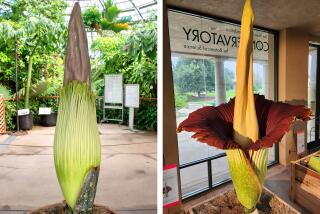<i> Polygonum capitatum </i>
- Share via
Pink clover blossom or knotweed
Perennial ground cover
In the Jungle Garden at the Huntington Library and Botanical Gardens, there is a beautiful riparian setting with Polygonum capitatum entwining and trailing through the exotic plants that surround the waterfall. A more common planting of Polygonum capitatum might feature the plant’s pink-and-green foliage beneath the like-colored, drought-tolerant rhapiolepsis.
The low-growing ground cover’s 1 1/2-inch leaves are pinkish green, turning toward crimson as the leaves age. The stems and flowers (which form rounded shapes like little heads on very long, thin necks) also are tinged pink. In Southern California, the flowers can bloom at any time.
Polygonum capitatum is a hardy perennial that will do well in dry, neglected or sandy soil but it looks best with watering. Sold in some nurseries as pink clover blossom, it also is called knotweed: It reseeds itself and can get weedy, invading flower beds. Happy in sun or shade, it can be planted in containers, neglected expanses (such as side yards) and among stepping stones.
It is tough, but in winter weather it can freeze below 28 degrees. After a freeze, the leaves die and look bad for a few months, but then will come back strong.
Usually sold in flats, Polygonum capitatum will spread rapidly. Spaced 8 inches apart, it takes about two months for the plants to fill in if planted in spring.
After February, flats of Polygonum capitatum should be available in local nurseries. If you have trouble finding it, have your nursery order it from B&C; Growers, Chino.






